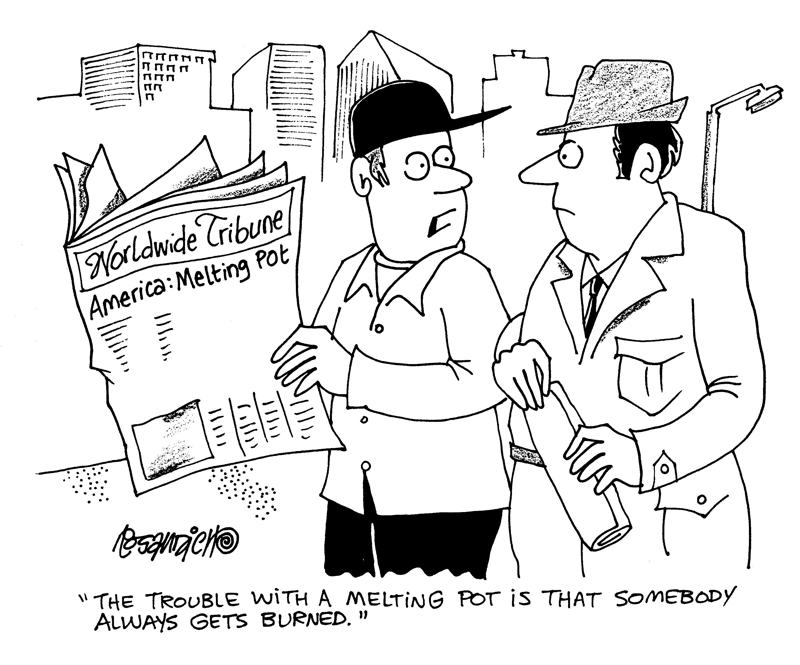
By successfully completing this unit, students should be able to...
Unit 2: Culture and Identity
This is one in a series of tutorials on intercultural communication. Anticipated completion time for this tutorial: approximately 80 minutes.If you are completing this tutorial for a course, your score on the included exercises will be recorded. Note that you can stop and come back and your score on completed items will be retained.
The objectives below can be achieved through working with the assigned readings, watching the presentations, doing the tutorial exercises, and posting to the discussion forums. 
By successfully completing this unit, students should be able to...
|
Key Concepts List (PDF)
This video excerpt from Crash (2004) introduces some of the key issues we will be dealing with in the this unit, namely perception, categorization and stereotyping.
|
First, watch the video (about 2 minutes long) below: Clip not available on YouTube - see stills on next page |
After watching the video, think about the following:
Now, turn to the next page for comments. |
|
1. The main complaint is having to wait for their order longer than white patrons. Also the other patrons in the restaurant were getting their coffee re-filled but no one came to ask him. But he didn't order coffee and didn't want coffee. Is his comment unreasonable? Or is it based on previous experiences? How real is prejudicial treatment of minorities in public spheres such as restaurants? 2. What is the stereotype about tipping that is mentioned? The stereotype that blacks don't tip is one of many that exist in America towards blacks. There are stereotypes about virtually all microcultures. Not all stereotypes are negative. Asian-Americans are stereotyped as being good at math, gay men as being neat and orderly. We'll be looking in this unit at what causes stereotypes and what the effect is on communication. 3. What happens when the black men and the white couple see each other? The upper middle-class white woman moves closer to her husband. When we encounter new objects or see other people for the first time, we tend to put them into categories. It's how we make sense out of a complex world and it's a universal human behavior. If we don't have much direct knowledge about the category of people we see, we tend to fall back on what information we have, most likely fairly superficial knowledge based on stories, news, TV shows, movies, etc. The woman here immediately puts the young men into the category of "young, black urban males", which for her likely has the association of danger.
The young black men are acutely aware of the fact that they are in an upscale, mostly white neighborhood. Ironically, that is why they are there, so as to be able to steal a high-priced car. How the people are perceived is not only based on skin color but also on dress and appearance. Ironically, the black men are not dressed in a way that could be perceived as threatening, for example, if they were wearing gang colors or even just a hoodie. The combination of appearance and setting can trigger strong opinions not necessarily based on objective evidence. The killing of a young black man in 2011 (Trevon Williams) in a mostly white suburban neighborhood came about in large part because of the location and the young man's dress (wearing a hoodie). 5. To what extent are stereotypes refuted or confirmed in this scene? The waitress in the restaurant is black, but she is seen as sharing in the prejudicial views of black men. The black man complaining about the restaurant service and about the stereotype that blacks don't tip does not leave a tip: "You expect me to pay for that kind of service." The white woman's fears are played out by the carjacking. This is a movie, and stereotypes are played for comedic and dramatic effect. But at the same time, there is a real and serious side here, namely that stereotyping is a complex issue. Sometimes stereotypes have no basis in reality, sometimes they do, sometimes stereotypes are self-fulfilling, sometimes they are embraced by the stereotyped people themselves. |
Communication is affected by how we perceive the other person. Our perceptive process is guided by our cultural identity. In encountering people different from us, we tend to fall back on conventional views and stereotypes. The further removed the others are from our own cultural background and the less we know personally about them, the more we tend to rely on stereotypes. In this chapter we will be dealing with ways we perceive the world and other people and with how we tend to put objects and people into categories. The process of categorization can lead to stereotyping and ethnocentrism, which in turn can result in discrimination and even racism.
Reading in PDF format
=> YouTube version | View/print presentation outline (PDF)
 Starts out funny, but turns to serious issue of telling your children about racism
Starts out funny, but turns to serious issue of telling your children about racismQ1: Cultural identity
Q2: Characteristics of microcultures
Q3: Stereotyping
Q4: Ethnocentrism
Q5: Racism
Q6: Groups